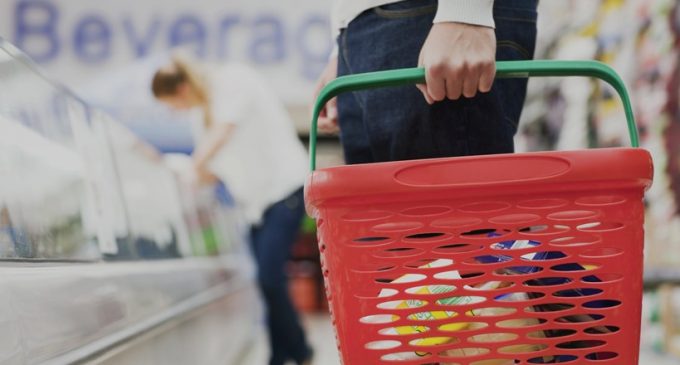Private Label Outperforms FMCG Brands in Europe

Private label continues to grow across Europe and is now outperforming brands in the majority of markets measured by big data and technology expert for consumer FMCG industries, IRI in its analysis of private label performance across eight major Western economies markets (UK, France, Germany, Greece, Italy, Spain, Netherlands and the US) during 2017.
Growing +4% year on year (yoy), private label value share across IRI EU markets is now 39.4%. Unit share also increased to 48.2% (+0.1pt). According to IRI, private label now outperforms national brands in more than half of the countries analysed, including the UK, Germany, Italy, Spain and the US.
Individual country performances vary widely with private label value share highest and growing most in the UK (52.5%), Spain (42.6%) and Germany (40.1%), and value share lowest in Italy (18.1%) Greece (16.3%) and the US (14.9%). France and Greece are the only countries showing value share declines of -0.7pt and -0.3pt respectively, largely due to the legacy of brand price wars. Netherlands share of 29.2% remained unchanged yoy.
IRI’s report points to three key reasons for this growing success:
- Private labels’ evolution to ‘private brand’ – innovative, consumer-focused ranges offering a finely poised balance between price and quality, which in turn earned more trust from shoppers who continue to search out the best value for money.
- Retailers capitalising on changing shopper trends – expanded ranges with investment concentrated on premium tiers in categories such as chilled ready meals, healthy snacking, affordable facial cosmetics, healthier food ranges, helping sway savvy shoppers from brands.
- A broadening retail landscape – Growth of discounters, specialist retailer banners, and now the latest big wave of disruption courtesy of Amazon and Google who continue to expand their FMCG footprint at pace. With this, the online giants are creating a platform ripe for further PL expansion.
Olly Abotorabi, Senior Regional Insights Manager at IRI, comments: “As economic prospects improve across the region it’s perhaps surprising to see private label in the ascendancy. Since the 1980s when private label products were often perceived as poor imitations of brands, today they are often the product of choice. Private label has come a very long way.
“Retailers have invested heavily, particularly at the premium end of the market providing improved quality and differentiation in a bid to drive customer loyalty. It’s evident in retailer messaging through to sales growth across a variety of categories. Products are increasingly aligned to evolved shopper habits and virtues whether that’s health, indulgence, portability, sustainability or environmental issues. However, premiumisation and heavy persistent promotional activity from brands is helping them maintain value share. Given the increased product quality, new ranges, emerging channel opportunities and recent buying alliance announcements between retailers we expect to see private label make further gains.
IRI reveals that the price gap between private label and brand is closing across the majority of countries. While the UK is seeing private label price increases, they are still behind the rate of brands. Conversely, private label price declines are ahead in Greece yoy in response to aggressive brand price cuts. The greatest differences are in France, Germany, and least in Italy where private label share is one of the lowest.
Click here to access the IRI Special Report ‘Private Label in Western Economies’
Other topline trends across Europe and the US:
- Private label share is highest in the frozen (47.1%) and chilled & fresh (44.8%) food categories (44.8%) with yoy share growth highest in the latter at the regional level.
- 7 out of 10 IRI macros categories boost their share across the region yoy – ambient, baby, chilled, confectionery, homecare, personal care and pet food/care
- Alcohol, soft drinks lose out due to brand premiumisation and a traditionally strong presence in the former. Brand innovation dilutes share in revived frozen category.
- Premium and organic private label forge ahead in France (11.2%) and Italy (10.8%) in terms of value yoy and represents 11% and 17% share of total private label respectively.
- Private label grows across all income groups and generations in the US, with millennials leading the charge.
 Olly Abotorabi adds: “Our key take outs from the report are that consumers are increasingly intent on searching out value for money, despite improving economic prospects. Expectations are heightened, choice and availability greater across an expanding retail landscape. Retailer and manufacturer collaboration remains vital on the route to developing trusted ‘private brands’. Deeper understanding of pricing, promotion and assortment as levers to drive success and loyalty are essential as the battle to win share of transaction intensifies.”
Olly Abotorabi adds: “Our key take outs from the report are that consumers are increasingly intent on searching out value for money, despite improving economic prospects. Expectations are heightened, choice and availability greater across an expanding retail landscape. Retailer and manufacturer collaboration remains vital on the route to developing trusted ‘private brands’. Deeper understanding of pricing, promotion and assortment as levers to drive success and loyalty are essential as the battle to win share of transaction intensifies.”
Country-level trends – summary:
UK
- Private label share grows for the fourth consecutive year, partially due to consumers switching as prices rise, but also as premium ranges showcase quality credentials and expand further.
- Retailer range cuts continue in a bid to reduce complexity and cost, with brands being culled ahead of PL.
- Promotional support decreases for PL and brands in a bid to offset rising costs, benefitting the top-line.
- Brexit continues to generate uncertainty. While full implications are still to be realised, a weaker pound has led to hikes in ingredient costs. Brand ‘shrinkflation’ exercised by FMCG manufacturers in the wake of the referendum has not been lost upon consumers and partly helped to trigger trade out from brand to PL.
- Homecare delivers most notable share gain from PL as shopper recessionary behaviours extend to household products. Ambient sees second biggest value share increase, with range expansion in on-trend categories such as savoury and sweet snacks evident. Alcohol value grew despite dynamic growth of branded premium beers/spirits yoy. PL wins in wines, sparkling wines, and emerging ready to drink mixes.
Germany
- PL share passes 40%, growing strongly in value ahead of brands in a more buoyant economy.
- PL price index sees the biggest change, closing the gap to brand by +2.1pts in the latest year. PL products on average are 36.5% lower. High price inflation in dairy combined with retailers investing in quality and more premium tier products are key factors.
- Range is growing at the expense of brands within food generally yoy and quality is improving particularly in Frozen and Chilled. This overshadows the growing acceptance and influx of brands into discounters, which has a negative bearing on underlying unit share.
- Hard discounters promote PL in Germany for the first time, helping push up % volume sold on promo.
- Chilled sees biggest increase in PL share (+1.6pts yoy). Dairy categories continue to witness high levels of price inflation, helping push up value share. Frozen share is highest at 55.2% as hard discounters dominate. Soft drinks – poor summer weather, brand premiumization, including tonics, as well as downsizing in packs and increased listings in discounters continue to tip the scale in favour of brands.
France
- PL share declines consistently during the last 4 years due to brand price wars. In 2017 this trend slowed, as key retailers outline intentions to reverse this trend through greater PL investment.
- Price gap vs. brand closes yoy due to enhanced focus on premium ranges, which grow +9% in total yoy.
- Development of organic PL ranges signals a switch in focus and retailers meeting changing consumer habits. Over 50% of P/L launches in the last year are organic, leading to high annual growth of +15% yoy.
- Evolution across channels visible, value ranges gain some traction within ‘Drive’ e-commerce yoy, while new concepts such as Carrefour’s ‘Bon App’ urban convenience stores stock a large range of P/L snacks tailored to on-the-go consumers.
- Legislation change will restrict aggressive nature of brand price cuts and push retailers to re-focus.
- Chilled sees the most notable decrease in PL share yoy. Heavy decline in milk, foie grois and other chilled meats drive. Brands win ahead in ready meals, sandwiches and fresh salads. Alcohol’s rise led by branded premium beers and spirits, impacting PL share negatively yoy. Baby is the one category in which P/L wins value share yoy, largely due to sales gained from brand in nappies and infant milk.
Italy
- P/L share grew favourably thanks to trading up across ranges while consumers maintain a perceived continued focus on value for money. This led to the highest value share point since 2013. Gains mostly from food and drink segments, overshadowing erosion in homecare.
- Price increases yoy across macro food and drink categories also paint a comparatively positive picture as non-food departments came under price pressure.
- New product development is instrumental in boosting PL. Top retailers Co-op Italia, Conad, Esselunga, Selex, Auchan and Carrefour have all moved to improve product relevance and quality.
- Aldi entered the market in March 2018 and will challenge the current market complexion, with a compelling mix of low prices and quality PL products.
- Chilled & Fresh sees the biggest increase in PL share yoy, with increased focus on healthy eating and snacking driving fruit and vegetables up. Convenience wins through too, despite a local preference for fresh. Ready to eat meals experience high double-digit growth yoy, with Private Label at the forefront.
- Frozen Brands increase dominance helped by more promotions and increased presence in frozen fish and ice cream categories. Baby PL steals share yoy, owing to competitive positioning on products such as wipes, nappies and to a lesser extent in infant milk.
The Netherlands
- After a period of long-term growth P/L sales and share are now stabilising. There are three main reasons. First assortment growth has plateaued. Second, retailers have rationalised moving from three PL tiers to one good quality product tier, priced competitively. Third, the diminishing growth of hard discounters reduces the momentum of PL sales growth from this channel.
- Leading retailers like Albert Heijn are taking steps to improve quality and appeal of everyday ranges, by reducing sugar content, or evolving fresh options for on-the-go consumers. No. 2 player Jumbo is focused on fulfilling the full food journey by integrating foodservice labels in retail and expanding with the acquisition of Emté
- Opportunities remain to re-focus PL as a quality, differentiated range of products as opposed to a cheaper alternative. The latest retailer initiatives can be a stepping-stone to building trust and driving future trade-up to more premium propositions.
- Chilled and Fresh growth is sustained due to high price inflation across dairy categories, milk prices in particular increasing as much as +12% yoy. This has resulted in reduced consumption. Ambient share trends downward due to increased pick-up of branded cereals, soups and savoury snacks yoy. Homecare increased ‘A’ Brand listing within discounters come at the expense of PL and provide a more attractive price point to Grocery shoppers.
Spain
- PL share is the second highest across the region (42.6%), accounting for half of all consumer unit sales in 2017, and maintaining its upward trajectory despite improved economic conditions in the last few years.
- Value Share is above 40% in 5 of 10 key macro categories; strongest in Frozen and Homecare, lowest in Confectionery and Alcohol.
- Strong retail brand evolution – leading retailer Mercadona driving shopper loyalty and bridge the gap to national brands through trusted and continuously evolving own brands such as Hacendado.
- Pet sees strongest PL share growth yoy aided by range development and increased sales of more premium dog and cat food products. Chilled and Fresh gains comes from retailer ready meals, charcuterie and yogurt based products. Ambient PL sales expansion is aligned to the on-trend growth of savoury snack products, including nuts and seeds, as well as canned goods including tuna.
Greece
- PL share has suffered across macro categories during 2015 and 2016 and has only lately showed signs of stabilising in 2017. This despite continued consumer demand for low cost products. The pressure derives mainly from deep-cut brand promotions. Add to this the exit of Grocery chain Carrefour/Marinopoulos, so PL has been harder to attain for shoppers in Greece.
- PL price index gap to brand increases in contrast to other countries in the region. Retailers look to stay competitive and bring shoppers in.
- Branded manufacturers promoted aggressively in 2017 to win a share of transaction. This won’t be sustainable, so the challenge of justifying higher price points and re-building brand equity as conditions steadily recover, needs careful consideration.
- Frozen is dominated by Brand in contrast to other countries in the region. PL share decreases as brands expand in key categories such as Vegetables and Pies. Baby strong category price deflation drives PL value share down ahead of brand, underlying demand for products does not improve as a result. Soft drinks more frequent and aggressive Brand promotions take share away from PL yoy.
US
- A positive year for PL as topline sales (+4.3% yoy) and share outperform total FMCG (+1.3%). Value share jumped by+0.5pt to 14.9% yoy. Retailers took a bigger proportion of sales across 8 of 10 key macro categories.
- Channel performance varies. Share is up in Club, with Frozen and Beverages showing strength. Convenience also sees positive momentum, mainly in Chilled and Beauty.
- PL price index gap increases despite an upturn in average price yoy. Brand prices increased faster. The differential is though small, PL products are only 20% cheaper on average vs Brand in the US. Only Italy has a smaller price gap in the EU.
- All income groups show a marked uptick in PL sales, emphasising increased relevance, quality and trust deployed across the spectrum amongst consumers.
- Millennials lead the charge as PL sales grow across all US consumer generations.
- Opportunities for PL to gain a stronger foothold remains. Share in the US is comparably low benchmarked vs 7 IRI EU countries. Consumers evidently are more trusting, particularly younger generations. Confectionery, Alcohol in particular have low PL equity, retailers could focus their attentions in the future to premium tiers here. Discounter, specialist and online retailer expansion will give ample opportunity for a continued rise in PL presence.
- Frozen growth is powered by strong gains in fresh seafood followed by ready meals, Meat, Vegetables and Pizza categories.
- Chilled PL upturn stems from strength in Meat, Seafood, Pasta categories and high growth in from lunch solutions.
- Pet share gains for PL are by way of premiumisation in pet treat and pet supplies, where underlying pack sales are actually flat yoy.
- Baby category sales growth in wipes and food signal increased equity of retailer own products, a trend mirrored by many EU countries. a platform that enables growth in new sub-categories such as baby and gifts and toys.
- Personal Care sees PL share benefit from explosive growth in facial cosmetics, hair accessories, while in health growth ahead of Brand in anti-smoking, vitamins and adult incontinence.


































